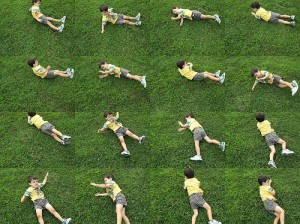Anthology Poet Highlight 6/82: Mark Bennion, “Still Life“ (Scroll down)
(My reading of Mark’s poem)
Mark Bennion’s first collection, Psalm & Selah is a great example of what a good poet can do in response to the Book of Mormon, which is to explore the stories many Mormons know so well in ways that shed new light on them, in ways that show the human connections underlying scripture, and to do so without becoming doctrinaire. I find that same focus on connection in Mark’s poem, “Still Life,” which appeared in Meridian Magazine Online in early 2004. (Since Meridian wiped its backlog clean last year for some crappy reason, I thank the Wayback Machine gods for providing, well, a way back to the online version of Mark’s poem.)
In “Still Life” the poet captures that childhood longing (though I don’t think kids see it that way) to forge some union with the earth, with the people that surround them. Such efforts are generally punctuated with the dynamics of genuine play, something that somehow falls away from us as we mature. I forget the last time I rolled down a grassy hill with a friend. My brother and I used to do it, you know, when we were younger. And that experience jibes with what the poet’s captured here: two boys (brothers, perhaps, or good friends; maybe both) who “lived for dizziness” “at dusk” (line 1), “roll down the backyard slope” (2). With each turn, they become more and more oblivious to what’s going on around them. They invest themselves so heavily in the moment, in present sensations, the viscerality of motion sickness and boyhood play, that they don’t see themselves growing up. They don’t notice the sun drop below the horizon. They don’t know, perhaps, that they’re engaged in the ephemerality of life on a slowly dying earth.
And yet, perhaps because of this ignorance, they’re enjoying every second of it. And I think the poet has, too, as he’s re-created this moment. This poetic play, however, is grounded in the reality of growing up. The poet realizes (as the closing lines suggest) the end of Day draws near, that the sun (read: mortal life) must be baptized by the night (read: death). He also realizes, I’m sure, what this image implies: death isn’t the end. The circularity of his language, of his imagery suggests the circularity of life, that to go is to return, that to die is to take a step closer to Life (capital L) and godhood.
But for now, while the Day lasts, let’s indulge the poet in his moment of play; let’s roll down the slope of language again and again and again until we’re so dizzy we lurch or until Mom calls us in for dinner. And even beyond.
Poetry (as art) helps me remember that life isn’t all about growing up; sometimes we just have to relive the small moments, to take our (linguistic/aesthetic/childhood) thrills when we can get them. Because otherwise, everything just seems so dark.
(9/30/2014: Edit to add audio file.)


I can’t wait for my copy of the anthology to arrive. Sounds like there’s good stuff in there.
Paragraph 2 of this review gave me a good idea for a poem. Thanks.